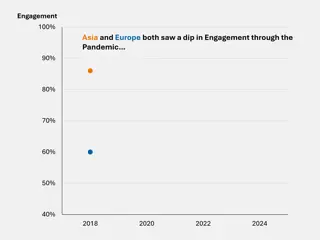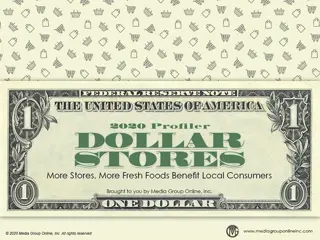Strategies for Sustained Growth of Instacart Post-Pandemic
Instacart, an online fulfillment service, has experienced growth during the global pandemic but faces challenges post-peak in April 2020. To sustain growth, Instacart can adjust pricing, pursue licensing IP, and enhance its platform. By leveraging its expertise in supermarket data, last-mile delivery, and e-commerce, Instacart aims to continue partnering with supermarkets and attracting customers in a changing market landscape.
Download Presentation

Please find below an Image/Link to download the presentation.
The content on the website is provided AS IS for your information and personal use only. It may not be sold, licensed, or shared on other websites without obtaining consent from the author.If you encounter any issues during the download, it is possible that the publisher has removed the file from their server.
You are allowed to download the files provided on this website for personal or commercial use, subject to the condition that they are used lawfully. All files are the property of their respective owners.
The content on the website is provided AS IS for your information and personal use only. It may not be sold, licensed, or shared on other websites without obtaining consent from the author.
E N D
Presentation Transcript
Instacart: Strategies for sustained growth post-pandemic Emerald Deku, Oluwabanke Shodimu, Rick Desloge
Background Instacart is an online fulfillment service in the USA and Canada that connects grocers with customers through personal shoppers that fulfill and deliver orders Revenue is generated from both grocers and customers Customers pay delivery and service fees Grocers pay 10% per order Costs Shoppers Technology Pay annual subscription No delivery charge Customers Don't pay annual subscription Pay $9 fee on per delivery
Retailers: Instacart partners with supermarkets Last mile delivery Managing retailer apps & websites Instacart's Current Business Model Consumers: Instacart values customer relationships An app feature for customers to communicate preferences and talk with shoppers Over-train customer service teams CPG Brands: Charging food companies for advertising brands A self-service advertisement platform Instacart already makes 0.13% of the annual ads spend in the grocery industry and aims to increase this by 2022 to 0.44% Shoppers: A structure to manage and train shoppers with retailer layout design A welfare program for shoppers
Shifting buying habits of customers Global pandemic was a boon to Instacart's model First positive cash flow since pandemic "Five years of growth in a matter of five week" Added numerous retail partners Is this sustainable? Customer's appetite for online grocery shopping post-pandemic is unclear YOY growth is slowing after peak in April 2020 How can Instacart gain continued patronage from both supermarkets and customers?
Things Instacart does well Expert in supermarket data Aggregate customer shopping data Ability to model data Last mile delivery E-commerce Supermarkets are traditionally tech averse Asset-light Ability to pivot business into numerous modalities and forms Brick and mortar infrastructure paid for by supermarkets
Recommendations 1 2 3 4 Adjust pricing for grocery stores Pursue licensing IP (Platform) to grocery and consumer-goods stores - "Powered by Instacart" Launch a robust advertising platform aimed at consumer goods manufacturers for direct placement of ads/promotions Long term: Acquire a national grocery store chain
Differentiated Re-Pricing Strategy Grocers are agitating over the high fees on orders ( within 5% to 10% per order) which seems abnormal when compared to the lower sales industry margins of less than 2% Revise current pricing model Offer differentiated prices per grocer for the high-end and low-end Retailer & Grocer segment Introduce a cap on fee per order Add incentives to retailers such as 'fee holidays'
Projected Sales with Re-Pricing Policy Assumptions Average grocer fee of 7% Projected Growth in volume of 5% Revenue per store growth from $33,000 in 2021 to $34,650 in 2022
License IP (Platform) to Grocery Stores - "Powered by Instacart" Instacart charges grocers, not customers Grocers raise prices for all customers to cover costs of Instacart, creating value Requires minimal capital investment Maintains low fixed asset costs; drives profitability Gives grocery stores access to customer shopping data Creates value and allows Instacart to charge (high) licensing fees With data, grocery stores can more effectively order from distributors Instacart can expand to additional retail partners Allows grocery stores to own relationship with customers Consistent brand image for stores, Instacart cannot dilute stores' brand image Increases value for customers at grocery stores that use Instacart More effective layouts and traffic patterns at stores Shifts costs of shoppers to grocery stores Mitigates risk of shopper unionization; Grocery stores would cover shopper benefits
Launch a robust advertising platform aimed at consumer goods manufacturers for direct placement of ads/promotions Data aggregated by Instacart is incredibly valuable to consumer goods firms Provides granular insights into customer spending trends Informs production and delivery timelines Creates a mechanism for combating industry cycles Allows for targeting of shoppers in real time In tandem with "Powered by Instacart", manufacturers can deliver promotions to customers on-demand Creates additional revenue source that can be adapted to in-store and at home use Customers can be targeted both in-store and at home
Long Term Growth Strategy Potentially acquire a national grocery store chain With online sales already falling by 25% in 2021 and a possible pandemic ease, e- commerce would not be as profitable over the next 5 years Instacart's current valuation of $39B signifies a healthy growth by over 1000% An IPO will increase Instacart's current valuation and boost the company's capital infrastructure required to enter the brick- and- mortar grocery market
Conclusion Instacart would like to maintain unprecedented growth experienced during the pandemic Sustaining this level of profitability seems unreasonable, given shifting consumer buying habits However, Instacart is an expert in last mile delivery, data, and e-commerce First, Instacart should adjust retailer pricing Next, Instacart should license IP and Create an advertising platform Long-term, Instacart should acquire a grocery store chain























